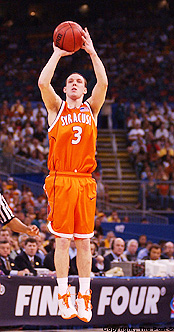The
2014-2015 Syracuse basketball season should be an interesting one. It has been quite a long time since the Orange entered a season with so much unknown about the team. The expected departure of C.J. Fair and Baye Moussa Keita, along with the early departure of Tyler Ennis and Jerami Grant have left the Orange with a lot to be replaced.
DaJuan Coleman continues to remain hurt, and the most experienced returning sophomore Tyler Roberson only played in 20 of the teams 34 games. The only 'known' quantities are returning starters Trevor Cooney and Rakeem Christmas, and reserve swingman Michael Gbinije.
Cooney and Christmas are both inconsistent players, with flashes of outstanding play, and periods of disappointing play. Normally on any given season, you can find some dependable returning upperclassmen, or at least one star to rally the team around, but that is not the case this year.
The Orange are going to need Cooney and Christmas to both be more consistently good in their play, and Christmas will need to be a bigger part of the offense. The freshman Chris McCullough and Kaleb Joseph are going to have to contribute quickly, and the sophomore trio of Roberson, B.J. Johnson, and Ron Patterson are going to have to be ready to play. Those last five mentioned players all have a lot of potential; it will be curious to see who has matured and developed since last year.
The last time the Orange had a season with this much doubt would likely have to be
1983-1984. This was Pearl Washington's freshman year; in restrospect it seems funny to question that year, but there was concern if the Pearl's playground style would translate to the NCAA, and how good would he really be. Plus, regardless of his talent, he was a true freshman, and the early 80s was not an era where most freshman excelled.
Syracuse was coming of a good (but not great) 21-10 season, with 9-7 in the Big East. The trio of Erich Santifer, Leo Rautins and Tony Bruin had all graduated. Those three had been starters since their sophomore season. Gene Waldron and Andre Hawkins were returning players, but neither was a star. Waldon was a competent point guard, but most of the offense had previously gone through Rautins as a 'point forward'. Hawkins was limited on offense, undersized as a center, and prone to foul problems. Raf Addison was the key reserve returning, and he had shown some promise in his bench role; however Addison wasn't a highly recruited player, so there were not big expectations for him
Things worked out well for the Orangemen that year. The Pearl was as good as advertised, if not better. Addison turned into a star player, and led the team in scoring with a solid game of mid range jumpers and interior play. Senior Sean Kerins showed that he had learned something after four years on the bench behind Rautins and Bruin, showing a combination of perimeter shooting and rebounding.
Hawkins learned to be comfortable at the post, and became a reliable 10 point scored, and sophomore Wendell Alexis developed into a very important sixth man backing up the forward and center positions. The Orangemen would go 23-9, 12-4 in the Big East, and actually improved from the previous year.
You could argue the
2002-2003 season had as many question marks. The team had lost leading scorers Preston Shumpert and DeShaun Williams, and it was a team that had collapsed and had missed out on the NCAA tournament, having to settle for the NIT. However, the team did have three returning starters in Kueth Duany, Hakim Warrick and Craig Forth. Duany was a senior, and Warrick had played very well down the stretch, including in the NIT tournament.
Plus the Orangemen the highly touted Carmelo Anthony joining the team, along with highly rated Billy Edelin, and a scrappy sharp shooting guard Gerry McNamara. The team definitely turned out to be much better than anyone could have expected; winning Syracuse's first National Title one season after being in the NIT was definitely a tremendous feat. Anthony turned out to be as good as he was touted, and Gerry McNamara was much better than anyone could have anticipated. Warrick had improved tremendously, as had classmate Josh Pace, and Duany was a solid senior. The Orangemen unexpectedly did not have the services of Edelin for most of the regular season, but the team excelled.
So anything could happen in the 2014-2015 season. Jim Boeheim does have a good track record of exceeding expectations when the team is low rated; they are starting this year at #23 in the country.






